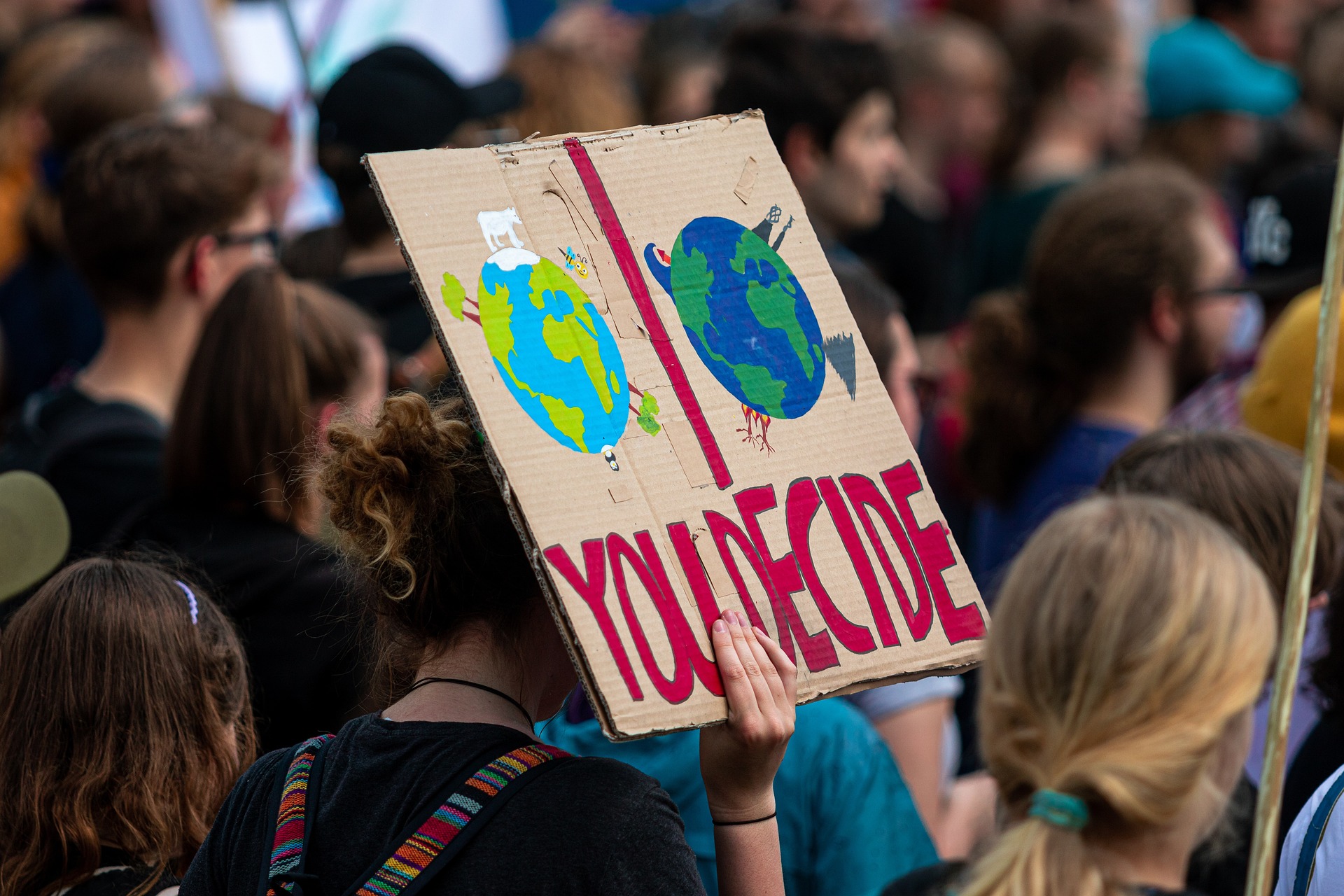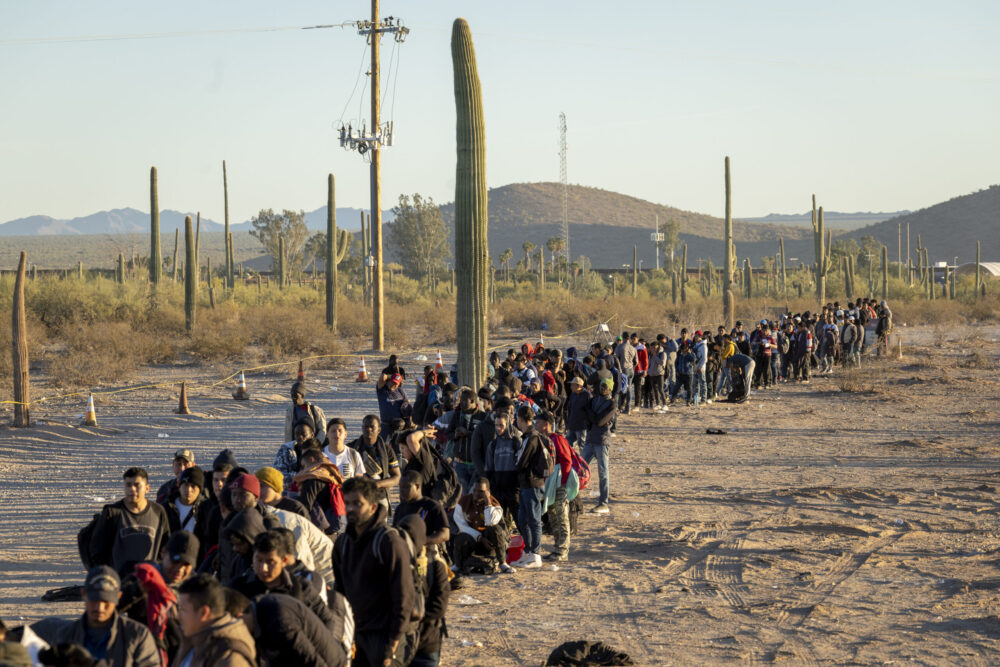Enviro protest has taken a turn toward punishing normal people.
The Day After ‘The Day After Tomorrow’

Climate apocalypse porn is a lever to impose a radical economic agenda.
In the 2004 Roland Emmerich film The Day After Tomorrow, the world is plunged into a new Ice Age after global warming causes the North Atlantic current to change abruptly. What’s interesting about this otherwise pretty standard big-budget disaster movie is not so much its basic premise—that climate change might actually lead to a much colder world, a fear which it’s easy (or convenient) to forget was widespread until quite recently—as what is done with it and the moral freight the film’s events are given.
When the Northern Hemisphere is made barren in an instant by superstorms that flash-freeze anything in their path, its peoples are forced to migrate south en masse and throw themselves at the mercy of the developing world.
Of course, there is a grim though rather contrived irony in this which is central to the film’s message. Aren’t the peoples of the Northern Hemisphere—and Americans especially—the ones responsible for the problem in the first place, burning all that fossil fuel and thinking there would never be any consequences for doing so? Wouldn’t the rest of the world be well within their rights just to leave us to our own mess?
Luckily for us greedy, wasteful northerners, the people of the developing world are a magnanimous bunch, prepared to overlook centuries of double-dealing and exploitation. Instead of being turned away, we are welcomed with open arms. The film ends with the newly installed U.S. president addressing the world from his makeshift residence in Mexico. Contrite and humbled, he acknowledges the depth of his country’s ignorance and of its gratitude to its new hosts. For a certain kind of liberal, I’d suppose that’s a happy ending.
It’s hard not to marvel at the absurdity of thinking the entire population of one hemisphere of the globe might be rapidly, and successfully, evacuated to the other in the event of a major disaster. The film requires a suspension of disbelief that no amount of CGI could ever lessen. Are we really supposed to believe that hundreds of millions of people—let alone hundreds of millions of Europeans and people of European descent—would be housed and fed in new lands, among vastly different people, many of whom bear open historical grudges, willingly and with good cheer? Really? Really? Funny thing is, though, that less than 20 years after the film was released, this idea is starting to gain currency as a genuine answer to the Climate Crisis, albeit with some important qualifications.
The direction of travel has now been inverted—south to north—and now the enormous migration must happen in advance to prevent unnecessary loss of life when the real climate catastrophe happens (which, of course, we can be certain it will). This is the argument of Gaia Vince’s Nomad Century: How to Survive the Climate Upheaval. “Our only way to survive the coming ‘species emergency,’” Vince claims, is “a planned and deliberate migration of a kind humanity has never before undertaken.”
But while the book is, frankly, mad—one of the most bizarre I’ve ever read—I also think it’s a book we need to contend with. As well as being deeply revealing about the modern liberal mind—its biases, hopes and hates, and its resentment-fueled fantasies—there are also good reasons to believe that some of what Vince advocates may actually end up happening.
This isn’t exactly a review of the book nor am I going to provide a rebuttal of its main argument, that hundreds of millions of people from the Global South, maybe even billions, should be deliberately rehoused in the Global North, above and below certain latitudes; and that we must utterly transform the way we live in order to achieve this. As far as I’m concerned, if you were the kind of person that idea appeals to, you wouldn’t be here in the first place. Its undesirability, not to mention its impracticality, is self-evident.
I’m also not going to engage with the climate science presented in the book, except to point out that Vince relies a lot more heavily on rhetoric than fact in order to build her argument and to present her “solution” as being all-but-inevitable. I trust you, the reader, to have sufficient intelligence to see the various ways climate science, and the global ecosystem that has grown up around it, is open to challenge.
Really, I want to do two things: bring the book’s arguments to your awareness, since you’re probably not likely to read the book and you wouldn’t enjoy it if you did; and try to impress on you that, actually, despite the book’s manifest insanity, we need to pay attention. We have every reason to believe that climate change will be used to drive accelerated social and political transformation in the West and that migrants will be at the heart of these attempts. Even if only—only—millions come, our nations will change beyond recognition, maybe forever.
Come One, Come All
Nomad Century is basically an airport book. It has jacket recommendations from usual suspects such as Bill Bryson and from people with names that at least sound the part for a book that will tell us “where we are now and where we could be heading if we don’t make a fundamental change”: names like “Musa Okwonga,” “Ed Yong,” and “Kim Stanley Robinson.” “Mary Roach” tells us Nomad Century is “The most important book I imagine I’ll ever read. It’ll knock you flat.” Quite the recommendation—if I had a clue who she is.
On Twitter I’ve referred to the author herself, the aptly named Gaia Vince, as a “midwit science popularizer,” but, in truth, this only reveals half of what she, and others like her, do and are. More than just popularizing recent science, they repackage it into broad encompassing arguments, usually about issues facing humanity today or what might be called fundamental or existential—i.e., “big”—questions. Where did humans come from? What will humans look like in 1,000 years’ time? Why are we altruistic / selfish / warlike / religious / X? And so on, and so on.
This type of writer is increasingly visible—thanks no doubt to fora like TED Talks and New York Times podcasts—and given authority to make pronouncements in total disproportion to their status in the fields they claim as their own. The archetype is Yuval Noah Harari, author of Sapiens, Homo Deus, and 21 Lessons for the 21st Century. Vince does seem, at least, to be better qualified to talk about science than Harari, but barely. While Harari is an historian by training and did his PhD on the self-identity of soldiers in the Middle Ages, Vince did actually read science at the undergraduate level; though she’s not and never has been a research scientist. She was news editor for Nature and online editor of the New Scientist and has written for The Guardian and BBC Online. Still, not a proper scientist: a journalist.
Like Harari, Vince is a good friend of World Economic Forum honcho Klaus Schwab. She’s written about science and “emerging technologies” for the WEF since 2015 at least, and Nomad Century has been widely promoted on their website, including on its Book Club podcast. It’s no real wonder the thrift-store Palpatine likes Vince’s work since it’s very on-brand with the Great Reset.
The book feels like a kind of gameplan for the Great Reset, telling us exactly how we’re going to end up in that vastly transformed world in just a few decades time. Climate change and the brute fact of unprecedented mass migration will “demand” an unprecedented response from world governments so that the whole planet can live in a more equitable and environmentally friendly manner. This will involve top-to-bottom change to the way we live, travel, work, and eat, as well as the way we are governed, including the creation of global organizations with the reach and mandate to deal with this new reality. Nation-states as we know them, with their antiquated basis in shared ethnicity, language, and custom, will disappear.
The premise of Nomad Century is very simple. Climate change is going to get so bad over the course of this century that it will render “swathes of the world uninhabitable.” Not just more uncomfortable or dangerous, with more unpredictable weather—an extra typhoon here, some more flash-flooding there—but quite literally uninhabitable. The first two chapters of the book are dedicated to describing exactly how bad things are going to get, as Vince introduces us to “the Four Horsemen of the Anthropocene,” the “Anthropocene” of course being the name for our current age, in which man (Greek anthropos) and his behaviour have come to have consequences on a planetary scale for the first time. Fire, heat, drought, and flood will “transform the world,” she says. The true extent of this transformation is revealed by a host of graphs and diagrams.
Things don’t look good. If the world heats by four degrees Celsius by the end of the century, the only inhabitable places on earth, we’re told, will be in the far north and far south of the globe: Canada, Alaska, northern Europe and northern Russia, some of New Zealand and—would you believe it!—Antarctica, newly thawed (just in time!). The entire central belt of the world, right up to northern France and all the way down to Australia and New Zealand’s North Island, will simply be off-limits to us.
A rather remarkable caveat follows these opening prognostications of doom. A mere 30 pages in to her 260-page book, Vince concedes that it’s quite possible her predictions won’t come true at all. Instead of warming four degrees, the global temperature might only rise by one-and-a-half degrees. Big difference. But this is no matter, Vince assures us. You see the only way we can be sure of staving off disaster is to assume the worst. We have to act as if the world is going to heat four degrees even if it doesn’t.
Pointing out that a sane person doesn’t amputate their foot solely because an infected toe could, on some unspecified probability, become gangrenous, is beside the point. Doing so would assume that Vince’s purpose is, first and foremost, to “get the science right.” It isn’t, as becomes abundantly clear when you read the remaining 230 pages of the book.
What this as-if approach means, then, is that migration can be nothing other than inevitable and not just a bit more than is already taking place. More or less everybody who lives in the most densely populated latitudes of the world will die if they don’t move. That’s billions of people. Indeed, by 2050, the world population is projected to be 10 billion, so I should really say: billions—and billions more. Vince reckons at least 1.5 billion people will have to leave their homes by 2050, and as many as 3 billion by 2070. Our obligation, according to her, is to ensure that the suffering of these people is minimized to the greatest extent possible. Since they’re going to try to migrate anyway, we must bring them here in advance before the cataclysm hits. It’s the only option. Really, we should be doing this right now. “We shouldn’t wait” for governments to hammer out deals, she says.
The rest of the book is a combination of elaborate justifications and hopeful descriptions of exactly how a fraction of the earth’s land surface will be able to house all these extra billions of people. The descriptions are the typical geek-fodder you find on the WEF website (new mega cities! underground algae farms! maggot burgers! “wind-powered giant pumps to refreeze the arctic sea ice”!). Vince dedicates an entire chapter of the book to food, and everything she says is in line with the World Economic Forum plan for a global plant-based diet supplemented with novel forms of protein (the so-called “Planetary Health Diet”).
It’s the justifications that really deserve our attention. Vince needs us to know not only that this process is an inevitability but that it will be a good thing if we manage it properly. Although, by her own account, large parts of the planet will essentially be destroyed, we will have a golden opportunity to make our societies better—fairer, more sustainable, wealthier even—and also make ourselves better as individuals. At last, we can be freed from the fictitious attachments that have proven so dangerous and divisive and embrace our real identities as global citizens. As nomads.
Unsurprisingly, since she’s a liberal, what Vince really wants is that we should all be more like her: to love the things she loves and hate the things she hates. If you read the jacket of the book, you’ll know that she “has visited more than sixty countries, lived in three and is currently based in London.” Migration is our “superpower” as humans, she tells us, which we just need to rediscover and learn to use once again. For most of our history, movement, not sedentism, has been the norm. We are nomads by nature: we just happen to be sitting around now migrating “stuff” to us rather than moving ourselves to it.
Of course, accepting this has deep consequences for our sense of who we really are. Fixed identities, beyond a shared humanity, just don’t make sense in a world where people are constantly moving, crossing boundaries, and exchanging goods, ideas, and genetic material with one another. Vince employs a reading of Benedict Anderson’s theory of “imagined communities” that would shame an undergrad to make the case that nations literally DO NOT exist, and fondly quotes Bertrand Russell’s smug quip that patriotism is just “the willingness to kill or be killed for trivial reasons.”
“Nations, then,” Vance writes, “are an unnatural, artificial social structure that emerged out of the complexity of the industrial revolution, and they are predicated on a mythology that the world is made of distinct, homogeneous groups that occupy separate portions of the globe, and claim most people’s primary allegiance. The reality is far messier…”
But the benefits of migration extend well beyond helping to reveal our true inner nature as globe-trotting liberals with no sense of place or belonging. Vince dedicates an entire chapter, “The Wealth of Migrants,” to discussing the unalloyed economic benefits of mass migration. There are no real downsides, only misplaced “fears” about its effects. “Migration is an economic not a security issue,” she states baldly. Far from being a threat to safety or security, migrants are overwhelmingly “young energetic jobseekers.” Citing various hokey-sounding studies, Vince claims that maintaining any kind of control over national borders is akin to leaving “trillion-dollar bills lying on the sidewalk.” And who in their right mind would leave a wad of trillion-dollar bills on the sidewalk? I know I wouldn’t!
The “fears” that people hold about immigration are simply due to ignorance. Vince does a little better than some liberal commentators to disguise her contempt for opponents of immigration, but it’s not hard to feel that she’d like to say exactly what she thinks about such people. Which is, of course, that they’re just plain stupid. Yokels. Rubes. Racists. A basket of deplorables. The book, as you might expect, is seasoned… liberally with disapproving references to Brexit, Boris Johnson, and, of course, the dreaded Orange Man. “Social change is difficult,” Vince says, holding her poise expertly, because diversity “requires more investment in mental energy…. It’s far easier to go along with the same ways of thinking and doing things when everyone else thinks and does things the same way as you.”
In any case, immigration is the only real solution to Western demographic decline and an aging population. Vince knows full well the nerve she’s touching. She presses harder. “It”—I think you can guess what “it” is—“will happen, and it has happened before. As we have seen, the pale skin of Europeans is very recent in human evolutionary history. The original Americans, Europeans and Britons were dark-skinned until their land was colonized by pale-skinned Eurasian steppe people some 5,000 years ago in Europe, and by their descendants more recently from the sixteenth century in the Americas.”
So give it up, bigots. “It” will happen. “It” should happen.
Migration as Reparations
What are we to make of all of this, then? Isn’t it just, as I say, a strange book that reveals some of the darker recesses of the liberal mind in 2022? Yes, it is that, certainly. Gaia Vince is clearly unusual, even for a latter-day liberal, in her ambition and willingness to imagine total Western self-effacement—to “say the quiet part out loud,” as some like to put it. But I also think there’s more to it than that. In all likelihood, we won’t see three billion migrants deliberately rehomed in the West in the coming decades (just as we won’t see billions flee as the entire central belt of the earth erupts into conflagration). This doesn’t mean, though, that migration won’t increase significantly; that this won’t be a deliberate choice on the part of Western governments; or that climate change won’t be used as one of the principal justifications for such movements. All three things are possible, indeed probable.
As Vince herself notes, while “climate refugees” are not included in the binding UN Refugee Convention, which outlines the rights of refugees and the legal obligations of states to protect them, this is going to change soon. In a landmark judgment in 2020, the UN Human Rights Committee ruled that a state cannot send migrants home if they are deemed to be at risk from the effects of climate change there. This is a clear precedent. Look, too, at the recent proposal made at the COP 27 conference for polluting nations—or rather, Western nations, since China isn’t included—to pay “climate reparations” to poorer nations beset by weather-related disasters and even to nations like the Maldives and Vanuatu that have stubbornly refused to sink beneath the waves, in the face of decades of predictions to the contrary.
The proposal for reparations grew directly out of the devastating recent floods in Pakistan and Bangladesh, which the media, politicians, and activists all told us, in no uncertain terms, were the direct result of the West’s fossil-fuel emissions. The fact that it’s impossible to demonstrate any kind of strict causality between the two things—their floods, our emissions—doesn’t matter: the link has been made and is now accepted by our representatives in government. Here, then, is the political, legal, and moral framework for climate change to become an unchallengeable reason to migrate to the West from virtually anywhere else in the world.
It hardly needs saying that Western governments have demonstrated great willingness to use immigration to reshape their nations, with or without the approval of their citizens. While Germany and Sweden have become posterchildren for this process, especially since the Migrant Crisis of 2015, the situation in my native Britain is no less dire. One of the great post-fact revelations about the Labour governments of Tony Blair and Gordon Brown, as told by a former aide, was not just that their policy of mass immigration was totally purposeful but that it was designed specifically to “rub the right’s nose in diversity.” But if the British right, or what passes for the British right, had its nose rubbed in diversity for 13 years, the effect has not been what one might expect.
The Conservatives, who have now been in power in some form for just a year less than Blair and Brown’s Labour, have intensified the forced diversification that was intended to humiliate them. Net migration for the year ended June 2022 was 504,000, a record high. In 1997, when Blair first came to power, that figure was less than a tenth of what it is today—under 50,000 a year. And this tenfold increase has happened despite Conservative leaders promising time and time again, including at the last election, to reduce immigration to manageable levels, “in the tens of thousands.” “Conservative” indeed.
Western governments are addicted to mass immigration. There’s no indication that they’re going to be weaned off this addiction any time soon. In Canada, for instance, the Century Initiative, a group of academics, captains of industry, thinkers, and former politicians, including former Prime Minister Brian Mulroney, recently announced that it had decided to revive Prime Minister Wilfred Laurier’s plan for the country to expand to a population of 100 million. The goal is to reach this number by 2100, from a current population of 38 million. Canada has a relatively low birth rate for a Western nation—lower than the U.S.—and yet its rate of population growth is the highest, by far, of all the G7 nations at 1.4 percent annually. The U.S., by contrast, manages about 0.7 percent, the U.K. 0.6 percent, and France and Germany 0.3 percent. Japan and Italy both have negative growth rates of about minus 0.2 percent. How is this possible? Immigration, of course!
Immigration has allowed Canada to triple its population between 1939 and now, and if the good people at the Century Initiative get their way, it will nearly triple again in roughly the same time span. The professed reasons for this massive growth are to increase Canada’s GDP, strengthen its place on the world stage, and address the problems of an aging population and labor shortages, all of which are arguments made in favor of immigration in Nomad Century. The Century Initiative also hinges on the creation of new mega cities, just like in Nomad Century. In 2100, the greater Toronto area alone might house upwards of 30 million people, five million more than Shanghai today.
In a very real sense, the question of the reality of climate change is less important than the question of how the idea is used and will be used as a justification for social, economic, and political policy on the widest possible scale. With climate change, our political classes, hooked on immigration, have the potential to secure easy access to a near-unlimited supply. A single event like a war, for instance the Syrian Civil War, can cause massive short-term dislocation, but wars generally come to an end and people stop moving. A global state of emergency, established on the basis of ill-defined terms and with ever-shifting parameters, need never come to an end if it proves useful enough. The last three years have been ample proof of this.
The sooner conservatives and patriots wake up, the better. What they do after they’ve woken up will remain to be seen. But the price of inaction is almost too great to contemplate. Thankfully, we have fruitcakes like Gaia Vince to imagine it for us. The day after the day after tomorrow, we really could be living in a West we don’t recognize or belong in at all.
The American Mind presents a range of perspectives. Views are writers’ own and do not necessarily represent those of The Claremont Institute.
The American Mind is a publication of the Claremont Institute, a non-profit 501(c)(3) organization, dedicated to restoring the principles of the American Founding to their rightful, preeminent authority in our national life. Interested in supporting our work? Gifts to the Claremont Institute are tax-deductible.
The city’s residents never asked for this.
The philosopher’s focus on citizenship is consistent with Donald Trump’s message.
There must be accountability for the greatest mass migration in world history.
Will they continue to demonize voters or learn an important political lesson?
The injustice of an inhuman religion






